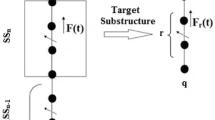Abstract
The measured frequency response functions (FRFs) are directly used to identify the bolted joint properties. However, the noise effect and the matrix inverse operations create ill-posed problems, and a small noise level may cause the identified result to be faulty. A sensitivity method is developed to avoid the ill-posed problems for identification of the dynamic parameters of bolted joints in this paper. To calculate the sensitivity of stiffness and damping for bolted joints, the sensitive values are used to determine the frequency ranges before the identification. Then, the equivalent stiffness and damping of bolted joints are identified by FRFs method in this range. All results of simulation and experiment show that the proposed method can improve significantly the identification accuracy. Additionally, the sensitivity method can be used to avoid an ill-posed problem by eliminating ill-posed FRFs in some frequency range before identification.
Similar content being viewed by others
References
R A Ibrahim and C L Pettit, Uncertainties and dynamic problems of bolted joints and other fasteners, Journal of Sound and Vibration, 279 (35) (2005) 857–936.
J S Tsai and Y F Chou, The identification of dynamic characteristics of a single bolt joint, Journal of Sound and Vibration, 125 (1988) 487–502.
J H Wang and C M Liou, Experimental identification of mechanical joint parameters, Journal of Vibration and Acoustics, 113 (1991) 28–36.
J H Wang and S C Chuang, Reducing errors in the identification of structural joint parameters using erroe functions, Journal of Sound and Vibration, 185 (5) (2004) 295–316.
S W Hong and C W Lee, Identification of linearised joint structural parameter by combined use of measured and computed frequency responses, Mechanical Systems and Signal Processing, 5 (1991) 267–77.
H Y Hwang, Identification techniques of structure connection parameters using frequency response function, Journal of Sound and Vibration, 212 (3) (1998) 469–79.
K T Yang and Y S Park, Joint structural parameter identification using a subset of frequency response function measurements, Mechanical Systems and Signal Processing, 7 (1993) 509–30.
Y. Ren and C. F. Beards, On the importance of weighting on FRF joint identification, Proceedings of the 11 th International Modal Analysis Conference, FL 1993 1606–1611.
Y. Ren and C. F. Beards, A new receptance-based perturbative multi-harmonic balance method for the calculation of the steady-state response of nonlinear systems, Journal of Sound and Vibration, 172 (1994) 593–604.
W Liu and D J Ewins, Substructure synthesis via elastic media, Journal of Sound and Vibration, 257 (2) (2002) 361–379.
T Yang, H S Fan and S C Lin, Joint stiffness identification using FRF measurements, Computers and Structures, 81 (2003) 2549–2556.
D Čelič and M Boltežar, Identification of the dynamic properties of joints using frequency- response functions, Journal of Sound and Vibration, 317 (2008) 158–174.
Y Ren and C F Beards, Identification of joint properties of a structure using FRF data, Journal of Sound and Vibration, 186 (1995) 567–587.
Y Ren and C F Beards, Identification of “effective” linear joints using coupling and joint identification techniques, American Society of Mechanical Engineers Journal of Vibration and Acoustics, 121 (1998) 331–338.
Tieneng Guo, Ling Li and Ligang Cai, Alternative method for identification of the dynamic properties of bolted joints, Journal of Mechanical Science and Technology, 26 (10) (2012) 3017–3027.
Ling Li, Anjiang Cai and Ligang Cai, Identification method for dynamic properties of bolted joints, Journal of Mechanical Engineering, 49 (7) (2013) 168–175 (in chinese).
Ling Li, Ligang Cai and Tieneng Guo, Identification and experimental research on dynamic stiffness of mechanical joints, Journal of Vibration Engineering, 25 (5) (2012) 488–496 (in chinese).
Roger A. Horn and Charles R. Johnson, Matrix analysis, Cambridge University Press, 2nd Revised edition (2012).
Author information
Authors and Affiliations
Corresponding author
Additional information
Recommended by Associate Editor Ki-Hoon Shin
Ling Li is a lecturer in the School of Mechanical and Electrical Engineering, Xi’an University of Architecture Technology. He graduated from Beijing University of Technology with a Ph.D. in Mechanical Engineering. His research interests include machine dynamics, mechanical behavior of the bolted joints and interfaces of the critical structures, non-linear mechanics, and accuracy design of machine tool.
Rights and permissions
About this article
Cite this article
Li, L., Cai, A., Guo, T. et al. Solution of ill-posed problems for identification of the dynamic parameters of bolted joints. J Mech Sci Technol 28, 3471–3481 (2014). https://doi.org/10.1007/s12206-014-0808-9
Received:
Revised:
Accepted:
Published:
Issue Date:
DOI: https://doi.org/10.1007/s12206-014-0808-9




